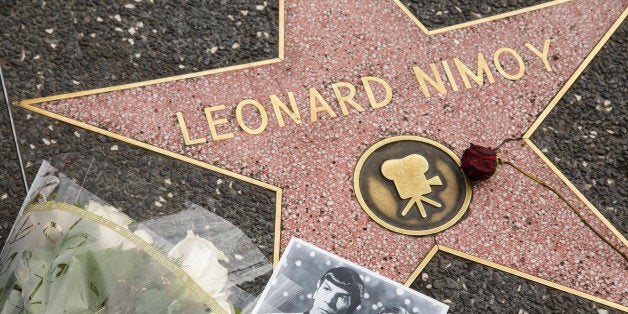
This morning, Leonard Nimoy passed away, taking with him a brilliant, sensitive soul and a character that has for half a century been one of the most popular and enduring reflections of our humanity. But when we mourn him, we mourn not only an actor, artist and humanitarian. We mourn a certain type of optimism about the future that is fading from memory, even as the world around us, for the most part, improves.
Earlier this week, it was revealed that ISIS had started to make good on their threat to destroy as many of humanity's most remarkable achievements as they can. Hammers were taken to Akkadian and Assyrian art and artifacts. Rare and priceless manuscripts were burned. And, of course, the slaughter of living, breathing humans continues, virtually unabated.
I would certainly never draw comparison in terms of tragedy, of course, and do not for one moment think that's what I mean to do. Rather, I draw one of possibility verses doom, our hopes verses our fears. Given Nimoy's association with an unabashedly optimistic vision of the future and his own work to celebrate the beauty of human diversity, I find it difficult to dismiss the contrast between gentle artist and violent regime, steward and denier of the past, champion of optimism and cheerleader of the apocalypse. Creator and destroyer. Everything good and everything evil.
In the end, this is the difference that will decide whether we, as a species, thrive or die. And which fate we deserve.
When people try to figure out how likely we are to make contact with an extraterrestrial civilization -- the premise that brought Nimoy into our collective consciousness -- they usually use some form or modification of the Drake equation. They calculate our number of potential alien pen pals by taking into account a number of factors: the probable number of planets that could support life, the fraction of those in which life might evolve to become industrialized, the number that come to use detectable telecommunication systems... But by far the most distressing part of the equation is the length of time that passes between a civilization developing something like radio and doing something so stupid that they wipe themselves out. Depending on that number, the estimate can change from tens of millions of alien civilizations to zero. Zero.
And boy, are we eager to do something stupid. ISIS is, of course, a destructive force almost without parallel. An aberration, many would argue. But there are near-infinite ways to march toward doomsday, and many of them are not particularly exceptional human behaviors.
We know that certain gases trap heat. So we pump them into our atmosphere by the ton. Then, when it warms up, we say, "Hey, we don't know what's causing that! Could be anything!" Governments around the globe spend a little over one and a half trillion dollars a year on making sure that we're all always ready to kill each other. And that doesn't account for all the weapons they already have, or the ones in the hands of militants, terrorists, private citizens who are pretty sure they might one day need an AR-15, or the ones that law enforcement agencies acquire to protect themselves from the citizens. We can still destroy cities at the touch of a button. The poverty and prejudice that must surely be robbing us of enormous potential still linger. We've even decided that it's time to bring back incredibly infectious and potentially deadly diseases, because hey, there might also be drawbacks to vaccines. I hate to be a pessimist in praise of optimism, and on many of these fronts the world is actually getting much better, not worse. But if anything is going to wipe humanity out anytime soon, there's still a very good chance that it will be our own stupidity.
Imagine a future in which we have indeed wiped ourselves out. Humanity never left our home world. Our future is no more. And, unless other civilizations are in the right place at the right time, capable of deciphering what we are, and had the foresight to build some really enormous antennas, so is our past. No one will ever experience Shakespeare or Li Bai, Picasso or Bellini, Billie Holiday or Maria Callas, Buster Keaton or Marilyn Monroe, The Bicycle Thieves or Cria Cuervos ever again. I will be the first to admit that most of us really have no business asking to live forever, but Audrey Hepburn? Caravaggio? And yes, even Leonard Nimoy? They deserve better.
It isn't all about our own actions, of course. Even if by some completely implausible miracle humanity decided to lay down its arms and hug everything out, the planet we live on still comes with an expiration date. Certain global disasters cannot be prevented. The sun, for example, is becoming more luminous. In the long run -- if something else doesn't beat it -- this will lead to the extinction of plant life on Earth and, with it, animal life as well. That date is counted in millions, not billions, of years.
The good news is that this need not mean the end of humans -- or dogs or cats or parakeets or Venus fly traps, either. You see, another factor in some versions of the Drake equation is colonization. Life might only develop on select worlds, but what if that life went on to tame others? The odds of their survival, and their accessibility, increase with each settlement.
So let's imagine another future. Here, humans live on countless planets orbiting countless stars. Our sun has long ago died, but humanity still survives. As does its past, in a way, even if they have forgotten their various Renoirs and Freuds.
In fact, if very deep space, faster-than-light travel is indeed possible and ever becomes a practical reality, the past might become more alive than ever. Future humans could actually see Earth's past unfold, just as we look 13 billion years into the past with telescopes today. Humans might literally watch the Earth form. Even if this kind of travel currently looks unlikely, certainly it must be worthy of our efforts.
All of this takes an enormous amount of work, of course. We need a means of travel that makes sense. We need to be sure our bodies can adapt to different suns, different soils, different levels of gravity. We need a means of communication that is practical over great distances. So many daunting undertakings, and we've barely taken a first step.
Is it really so much to ask? A real investment in human survival? NASA believes that the cost of a first trip to Mars would be around $100 billion -- a scary number, but only about 6.5 percent of what humans spend annually on speeding ourselves toward destruction. Mars One is trying to do it with a pittance of around $6 billion in money it hasn't raised yet, including revenue from corporate sponsorships and a proposed reality television program. As much as I wish for them to succeed, it seems at this point like a pipe dream. And Mars is barely a stepping stone toward the kind of travel that humanity is surely capable of. We have to start taking the future of our race, and every other species on this planet, seriously.
If humanity wants to continue, it has to shoot for the stars. The future, if we have one, is indeed a Star Trek, my friends. But it is also people like Leonard Nimoy -- artists, optimists, dreamers and thinkers. The people who will one day really take us to the stars.
